Related Research Articles
Toca da Boa Vista (BA-082) is the longest known cave in the Southern hemisphere. It is located within the municipality of Campo Formoso, 11 km east of the town of Lage dos Negros, in the State of Bahia, Brazil. As of 2007 it had over 120 km of mapped passages, which makes it the 13th longest cave in the world. Continued exploration faces typical temperatures of up to 30 Cº.
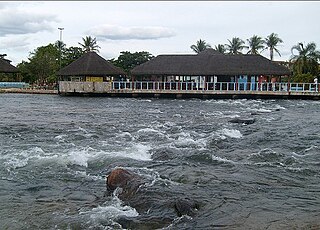
Correntina is a municipality in the state of Bahia in Brazil, 500 km from Brasilia and 980 km from Salvador. In 2020, the population was estimated at 32,191.
The caves of the Serro da Ramalho karst area in the municipality of Serra do Ramalho, a municipality of the same name in southwestern Bahia State, Brazil, have been explored since the early 2000s. The several large cave systems present a great biospeleological potential. Newly discovered species include the first troglobitic Amblypygi recorded for Brazil, Charinus troglobiusBaptista & Giupponi, 2003, an eyeless harvestman, an as yet undescribed genus of spiders (Ochyroceratidae), and a species of catfish.

Iraquara is a municipality in the state of Bahia in the North-East region of Brazil.

Gruta de Maquiné (MG-0243), also Lapa Nova de Maquiné, is the oldest and one of the most commercially visited caves in Brazil. It is located about 5 km (3.1 mi) from Cordisburgo and 143 km (88.9 mi) northwest of Belo Horizonte, in the State of Minas Gerais. The cave has seven huge chambers explored, amounting to 650 m (2,130 ft) (linear) and unevenness of the ground of only 18 m (59 ft). Safety measures like lighting, walkways and handrails allow a multitude of visitors to enjoy safely the wonders of the grotto where the whole journey is accompanied by an experienced local guide.
Gruta do Padre (BA-052) is a cave located halfway between the municipalities of Santana, Santa Maria da Vitória e Canápolis, in the state of Bahia, Brazil. It is currently the third-longest cave in the country being 16,400 meters long and unevenness of 125 meters. Discovered in 1914 by a priest who sought honey in hives that get stuck in the rocks, it was often a place of religious pilgrimage where the locals came to pay their promises until the 1950s.
Gruta das Areias is a complex of caverns located in the region of Lajeado, in the municipality of Iporanga, São Paulo, Brazil. It is therefore part of the Areias System, located in the southwestern part of the carbonatic area Lajeado-Bombas, on the right bank of the Betari river, in the municipality of Iporanga, southeast of the state. It comprises the caves Ressurgência das Areias (SP-016), the 5.565 meter-long cave Areias de Cima (SP-018) and the Areias de Baixo (SP-019) cave, also popularly called Areias I and II. It is also part of the so-called Açungui group of caverns formed between the Mesoproterozoic and Neoproterozoic, between 1.6 billion and 539 million years ago.
Guy Christian Collet was a French scientist, explorer and spelunker who came to live in Brazil after World War II. In the karstic region along the Ribeira valley in the State of Sao Paulo he began the exploration for caverns and grottos, becoming later founder and chairman of two speleological societies of deep respectability in the field of speleology in the country. He did work in the areas of underground biology, archeology, nutrition techniques in caves, besides having published several books and reports on the subject.

Gruta Casa de Pedra (SP-009) is a cave located in the karstic region of the Alto Ribeira Tourist State Park, between the municipalities of Apiaí and Iporanga, to the south of the State of Sao Paulo, Brazil. It is 2,930 meters long and features the largest cave mouth in the world, measuring 172 meters high. It is located in the final portion of the hydrographic sub-basin of the Maximiano stream which enters the cave for about 800 meters and flows into the Iporanga River. Its name derives from the size of its portico, recognized as the world's largest.
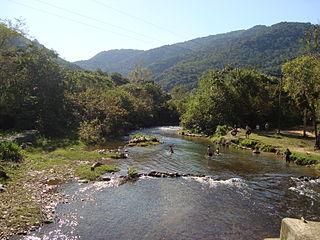
The Alto Ribeira Tourist State Park is a state park in the state of São Paulo, Brazil. It protects a mountainous area of Atlantic Forest and is known for its many caves.
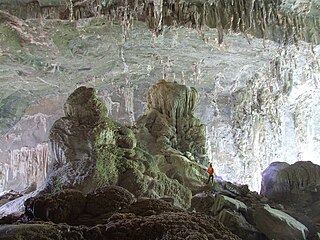
Caverna de Santana (SP-041), also Caverna de Sant'Anna, is a cave located inside the Alto Ribeira Tourist State Park, along the road connecting the towns of Apiaí and Iporanga, to the south of the State of Sao Paulo, Brazil. The Flowers' Hall, displaying thousands of flowers of aragonite, and the Taqueupa Hall as one of the many other formations of great scenic beauty found in the cave, are ranked among the most beautiful and ornated of the world.
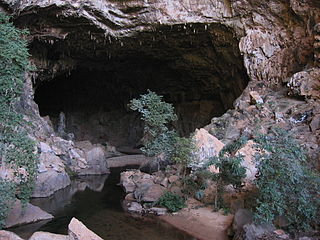
Lapa Terra Ronca or Caverna Terra Ronca I (GO-063), is a dolomitic limestone cave inside the area of the Terra Ronca State Park, which houses the largest collection of caves and grottoes in the midwest with a number of about 200 being that only Terra Ronca and Angelica are open for the tourists. It is located about 400 kilometers from Brasília, midway between the municipalities of São Domingos, Posse e Guarani de Goiás, in the State of Goiás, Brazil.
Toca da Barriguda (BA-0250) is a dolomite cave located in the municipality of Campo Formoso, in the State of Bahia. It measures 35,000 meters long and 61 meters deep, and is now considered a branch of the Toca da Boa Vista cave, being the second-longest in South America. The Coarazuphium formoso, a recently described a troglobite species of beetle found in the Barriguda cave.
Abismo Ouro Grosso (SP-054), also Gruta Ouro Grosso, is a 192-metre-deep (630 ft) shaft consisting of waterfalls and natural pools. It was created by the capture of surface rivers by carbonate rocks with subterranean drainage systems in an advanced stage of evolution. First explored by the German naturalist and spelunker Michel Le Bret in the 1970s, it is located at the Nucleo Ouro Grosso, within the borders of the Alto Ribeira Tourist State Park, in the municipality of Iporanga, 350 kilometres (220 mi) from Sao Paulo, Brazil.
Gruta da Morena (MG-0270) is a limestone cave, considered the third largest cave in Minas Gerais, 15 km from Cordisburgo, Brazil. Reaching 4620 meters long, it presents five entrances, various halls and a stream. It is close to the road of Povoado do Onça, 6 km from the city. To get to the cave, it is first necessary to go through a trail. This specific cave has been very recently included in the area of influence of Gruta de Maquiné, once a new species of arachnid has also been found inside the cave, being it the third troglobitic species of Brazilian Palpigradi found in this cave and of characteristic very similar to the previous species Eukoenenia maquinenses.
Conjunto São Mateus (GO-011) is a complex of caves measuring 20500 meters long and considered until recently as the largest in Brazil, being replaced by the Toca da Boa Vista. It is located inside Terra Ronca State Park, in the speleologic district of São Domingos, State of Goiás. It is one of the richest in speleothems including the famous "Hall of the Pearls", where visitors should go barefoot to avoid the transposition of sediment. It houses the typical fauna of the caves, including the blind catfish. Inside the cave flows the São Mateus river, forming beaches and leaving successive halls along the way.
Lapa da Mangabeira (MG-003) is a cave located in the municipality of Ituaçu, Chapada Diamantina, in the State of Bahia, Brazil. Presenting a horizontal projection of 3230 meters and unevenness of 40 meters, being one of the most important pilgrimage centers in the State of Minas Gerais.
Gruta da Cabana (SP-108) is a limestone cave located inside the Alto Ribeira Tourist State Park, in the municipality of Apiaí, São Paulo, Brazil. Although under the protection influence of the other caves along the Areado Grande creek, the cave lies outside the borders of the park. It measures 4185 meters long and 74 meters deep. Recent studies proved that the cave is connected to Gruta Desmoronada (SP-74) through a test conducted by a group of geologists.
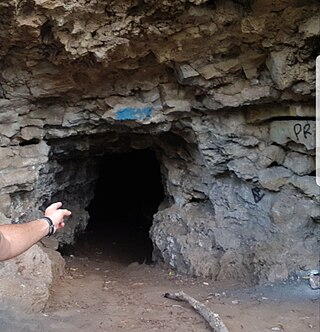
The Furnas do Cavalum are a group of four caves located in Machico, Madeira. Named after a local legend about a demon called Cavalum, who was imprisoned in the cave.
References
- 1 2 Martinelli, Ricardo de Souza; Sociedade Brasileira de Espeleologia (21 May 2007). "UPE continua o trabalho de mapeamento do Areado" (PDF). Sociedade Brasileira de Espeleologia Noticias. 2: 1.
- ↑ União Paulista de Espeleologia. "Cavernas Exploradas". UPE Cave. Archived from the original on 26 April 2012. Retrieved 1 January 2012.